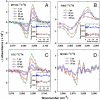Direct measurement of the protein response to an electrostatic perturbation that mimics the catalytic cycle in ketosteroid isomerase
- PMID: 21949360
- PMCID: PMC3189056
- DOI: 10.1073/pnas.1113874108
Direct measurement of the protein response to an electrostatic perturbation that mimics the catalytic cycle in ketosteroid isomerase
Abstract
Understanding how electric fields and their fluctuations in the active site of enzymes affect efficient catalysis represents a critical objective of biochemical research. We have directly measured the dynamics of the electric field in the active site of a highly proficient enzyme, Δ(5)-3-ketosteroid isomerase (KSI), in response to a sudden electrostatic perturbation that simulates the charge displacement that occurs along the KSI catalytic reaction coordinate. Photoexcitation of a fluorescent analog (coumarin 183) of the reaction intermediate mimics the change in charge distribution that occurs between the reactant and intermediate state in the steroid substrate of KSI. We measured the electrostatic response and angular dynamics of four probe dipoles in the enzyme active site by monitoring the time-resolved changes in the vibrational absorbance (IR) spectrum of a spectator thiocyanate moiety (a quantitative sensor of changes in electric field) placed at four different locations in and around the active site, using polarization-dependent transient vibrational Stark spectroscopy. The four different dipoles in the active site remain immobile and do not align to the changes in the substrate electric field. These results indicate that the active site of KSI is preorganized with respect to functionally relevant changes in electric fields.
Conflict of interest statement
The authors declare no conflict of interest.
Figures

 ) of approximately 20.2 debye is created from the movement of a single electronic charge over a distance of 4.2 Å during the passage from KSI–intermediate complex to KSI–substrate complex, which is similar in magnitude to
) of approximately 20.2 debye is created from the movement of a single electronic charge over a distance of 4.2 Å during the passage from KSI–intermediate complex to KSI–substrate complex, which is similar in magnitude to  debye created during photoexcitation of enzyme-bound C183 (see text).
debye created during photoexcitation of enzyme-bound C183 (see text).


Similar articles
-
Site-specific measurement of water dynamics in the substrate pocket of ketosteroid isomerase using time-resolved vibrational spectroscopy.J Phys Chem B. 2012 Sep 20;116(37):11414-21. doi: 10.1021/jp305225r. Epub 2012 Sep 7. J Phys Chem B. 2012. PMID: 22931297 Free PMC article.
-
Quantitative, directional measurement of electric field heterogeneity in the active site of ketosteroid isomerase.Proc Natl Acad Sci U S A. 2012 Feb 7;109(6):E299-308. doi: 10.1073/pnas.1111566109. Epub 2012 Jan 17. Proc Natl Acad Sci U S A. 2012. PMID: 22308339 Free PMC article.
-
Fluctuations of Electric Fields in the Active Site of the Enzyme Ketosteroid Isomerase.J Am Chem Soc. 2019 Aug 14;141(32):12487-12492. doi: 10.1021/jacs.9b05323. Epub 2019 Aug 2. J Am Chem Soc. 2019. PMID: 31368302
-
Electric Fields and Enzyme Catalysis.Annu Rev Biochem. 2017 Jun 20;86:387-415. doi: 10.1146/annurev-biochem-061516-044432. Epub 2017 Mar 24. Annu Rev Biochem. 2017. PMID: 28375745 Free PMC article. Review.
-
Accurate Calculation of Electric Fields Inside Enzymes.Methods Enzymol. 2016;578:45-72. doi: 10.1016/bs.mie.2016.05.043. Epub 2016 Jul 1. Methods Enzymol. 2016. PMID: 27497162 Review.
Cited by
-
Metal-ion effects on the polarization of metal-bound water and infrared vibrational modes of the coordinated metal center of Mycobacterium tuberculosis pyrazinamidase via quantum mechanical calculations.J Phys Chem B. 2014 Aug 28;118(34):10065-75. doi: 10.1021/jp504096d. Epub 2014 Aug 13. J Phys Chem B. 2014. PMID: 25055049 Free PMC article.
-
Integrating single-cobalt-site and electric field of boron nitride in dechlorination electrocatalysts by bioinspired design.Nat Commun. 2021 Jan 12;12(1):303. doi: 10.1038/s41467-020-20619-w. Nat Commun. 2021. PMID: 33436610 Free PMC article.
-
Photosynthetic reaction center variants made via genetic code expansion show Tyr at M210 tunes the initial electron transfer mechanism.Proc Natl Acad Sci U S A. 2021 Dec 21;118(51):e2116439118. doi: 10.1073/pnas.2116439118. Proc Natl Acad Sci U S A. 2021. PMID: 34907018 Free PMC article.
-
Measuring electrostatic fields in both hydrogen-bonding and non-hydrogen-bonding environments using carbonyl vibrational probes.J Am Chem Soc. 2013 Jul 31;135(30):11181-92. doi: 10.1021/ja403917z. Epub 2013 Jul 18. J Am Chem Soc. 2013. PMID: 23808481 Free PMC article.
-
Probing the electrostatics of active site microenvironments along the catalytic cycle for Escherichia coli dihydrofolate reductase.J Am Chem Soc. 2014 Jul 23;136(29):10349-60. doi: 10.1021/ja5038947. Epub 2014 Jul 11. J Am Chem Soc. 2014. PMID: 24977791 Free PMC article.
References
-
- Kraut J. How do enzymes work? Science. 1988;242:533–540. - PubMed
-
- Radzicka A, Wolfenden R. A proficient enzyme. Science. 1995;267:90–93. - PubMed
-
- Bruice TC. A view at the millennium: The efficiency of enzymatic catalysis. Acc Chem Res. 2002;35:139–148. - PubMed
-
- Kraut DA, Carroll KS, Herschlag D. Challenges in enzyme mechanism and energetics. Annu Rev Biochem. 2003;72:517–571. - PubMed
-
- Zhang X, Houk KN. Why enzymes are proficient catalysts: Beyond the Pauling paradigm. Acc Chem Res. 2005;38:379–385. - PubMed
Publication types
MeSH terms
Substances
Grants and funding
LinkOut - more resources
Full Text Sources

